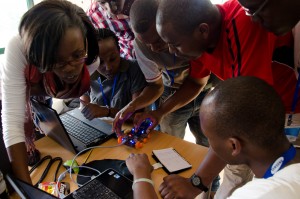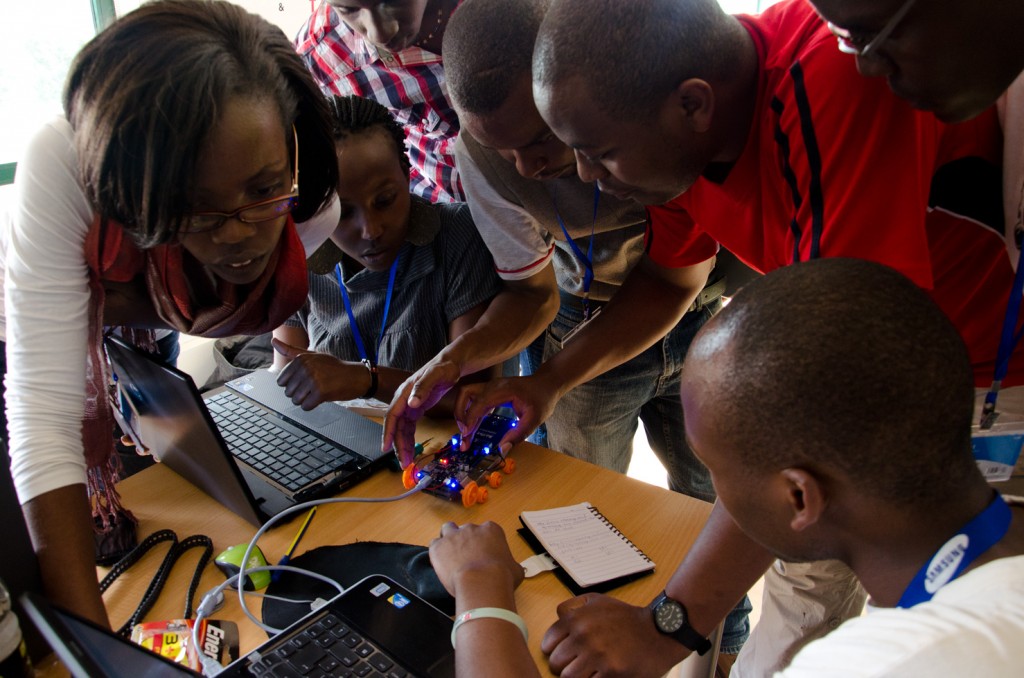
The 4th Industrial Revolution is driven by newer technologies, such as 3D printing, that are changing industrial processes by accelerating them and making them more flexible. With the right tools and training, young innovators in Africa have the opportunity to skip the second industrial revolution — traditional mass production — and leapfrog straight to digital manufacturing. This, in turn, can provide them with a path out of poverty.
Africa has shown an incredible ability to leapfrog older forms of technology in favor of adopting the latest. It skipped traditional landlines — as well as dial-up Internet access — and moved straight to mobile broadband. Digital manufacturing and 3D printing will revolutionise Africa’s manufacturing industry in the same way that smart phones and mobile broadband are transforming the service, trade and agricultural industries.
Next-Shoring, the ‘Next’ Frontier
The lack of an established manufacturing sector means that most Africans rely on importing items like machine parts, consumables, household goods, tools and building materials. As 3D printing becomes more versatile, African nations can digitally manufacture such objects domestically and reduce dependency on costly imports. It will create an environmentally friendly ecosystem that doesn’t require factories, machinery, labor or capital. The savings, both direct and indirect, will afford many people the opportunity to lift themselves out of poverty.
Although growth in the manufacturing sector has long been considered crucial for economic development, it usually represents a small part of African economies. In Nigeria, for example, manufacturing is still at an infant stage, accounting less than 7 percent of GDP, and the local industry depends on imports of raw materials and parts.
3D printing has the capacity to transform the supply chain. By 2025, two-thirds of global demand will come from emerging markets, according to McKinsey & Co. As that happens, a new trend of “next-shoring” is expected to move manufacturing areas close to where the raw materials or customers are, cutting down on distribution time and reducing costs. Next-shoring transcends geography and focuses on physical proximity to emerging markets, talent and customers.
Take the auto industry in Nigeria, with Ford’s decision to establish a presence and produce roughly 10 units a day for the market. Since Nigeria is a priority market in Sub-Saharan Africa, many companies are looking at how a base there can service the entire region. Reliance on highly specialised suppliers for complex parts can be reduced with 3D printing, and so can the number of suppliers involved across the supply chain.
Developing Skills for the Future
As we enter the 4th Industrial Revolution, one area of concern is how prepared Africa’s students are to become innovators in tomorrow’s economy. Countries will need to ensure that people have the skills they need to compete globally by investing in education and school-to-work transitions.
There are two primary entry points into the world of 3D printing. The first is the education sector. Priority should be given to getting the culture of 3D printing into schools so that youth can become conversant with the technology and increase their interest in science, technology, engineering and math (STEM).
We’ve seen first-hand the benefits of such programs, with Youth for Technology Foundation partnering with several secondary schools and universities across Nigeria to train several hundred students in human-centered design and 3D Printing. At the Federal Government Girls College in Owerri, 15-year-old Treasure developed a passion for 3D modeling and has been designing and printing rings, phone cases and other small consumables. She is now starting to think about how to market these products to others in her community and sell them in online marketplaces.
But employers cannot wait for the right applicants to show up at their doorsteps. They should work with education providers, especially at the tertiary level, to design curricula that fit business needs. They should also take the workplace to the classroom, by lending out members of their own staff to act as instructors and increasing the availability of work-placements programs and other opportunities for practical learning.
The second point of entry involves adding knowledge of 3D printing technology to Africa’s innovation corridors. For example, YTF partnered with the GE Garages Lagos program to expose entrepreneurs to the latest in advanced manufacturing technologies, while teaching them to drive innovation through rapid prototyping.
YTF supported one of the entrepreneurs from GE Garages, Tochukwu, who designed a reading stand device. The 3D Africa team helped to refine the 3D-printed parts for his product, which was a finalist in the Social Innovation Contest organised by the American Society of Mechanical Engineers, and Tochukwu was recently able to establish a replica 3D printing hub in Lagos.
Moreover, as the GE Global Innovation Barometer noted, there’s a strong sense among entrepreneurs that government should be more of an enabler and steward of innovation. Though opportunities abound for those interested in 3D printing and other innovative technologies, there are still many risks — including high levels of initial investment and marginal cost, lack of support from the government and a disregard for intellectual property issues.
However, the opportunities to unlock innovation and create employment opportunities through entrepreneurship are endless, and the youth of Africa stand to benefit from all of them.

